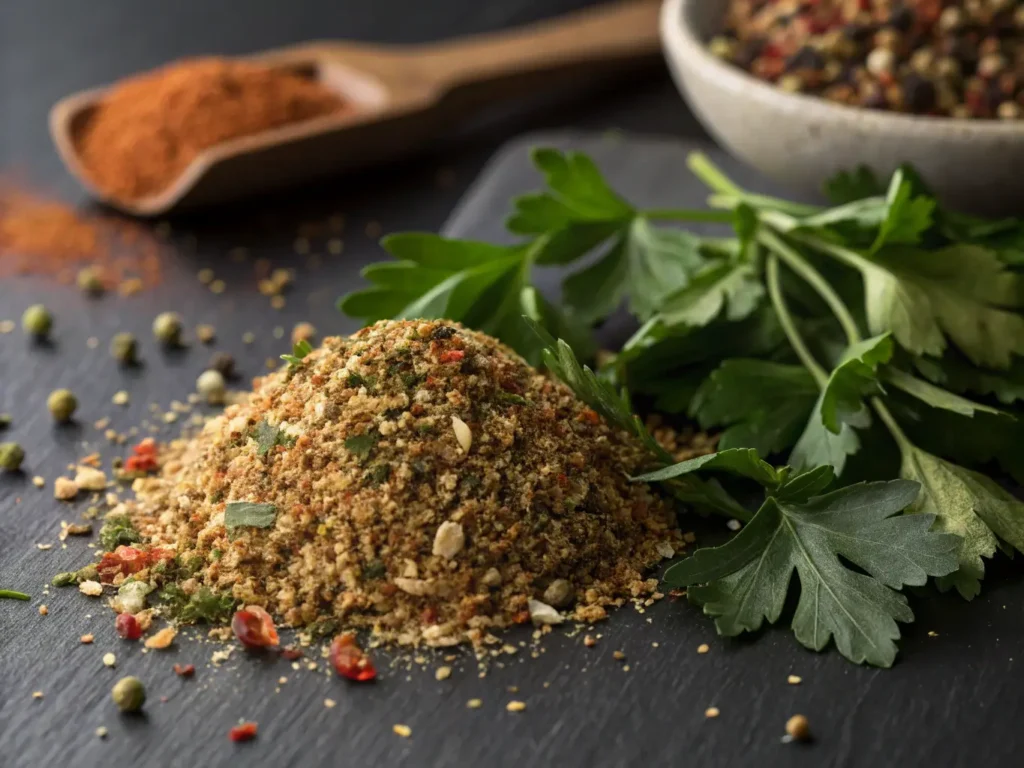Discover the secrets to perfect meatloaf seasoning. This guide offers tips, recipes, and variations to create a flavorful and juicy meatloaf every time, using simple, readily available ingredients.
The Importance of Meatloaf Seasoning
Why Seasoning Matters
The right meatloaf seasoning is essential for a flavorful and enjoyable meal. Indeed, the seasoning enhances the natural flavors of the meat. Also, it adds depth and complexity to the overall dish. Therefore, the selection of seasonings is crucial for a great-tasting meatloaf. Comparatively, a poorly seasoned meatloaf can be bland and unappetizing.
Understanding Flavor Profiles
Different seasonings create various flavor profiles. For instance, some seasonings add warmth and earthiness, while others provide brightness and acidity. Therefore, understanding how different spices work together helps you achieve a balanced flavor. Consequently, it is important to know what you want your meatloaf to taste like to choose the right seasoning.
Print
Fantastic Meatloaf Seasoning Guide
- Total Time: 5 minutes
- Yield: About 3 tablespoons 1x
Description
This homemade meatloaf seasoning blend is savory, aromatic, and perfectly balanced to enhance any meatloaf recipe. Just mix and store, great for beef, turkey, or veggie versions.
Ingredients
- 2 teaspoons onion powder
- 1 1/2 teaspoons garlic powder
- 1 teaspoon smoked paprika
- 1 teaspoon dried parsley
- 1 teaspoon dried basil or Italian seasoning
- 1 teaspoon salt
- 1/2 teaspoon black pepper
- 1/2 teaspoon ground mustard (optional)
- 1/4 teaspoon crushed red pepper flakes (optional)
Instructions
- 1. Combine all spices in a small bowl or jar.
- 2. Mix well to combine evenly.
- 3. Use about 1–2 tablespoons of seasoning per pound of ground meat.
- 4. Store leftovers in an airtight container in a cool, dry place for up to 6 months.
Notes
- Adjust salt and spice levels to your preference.
- This blend works great in meatballs and burgers too.
- Add a pinch of brown sugar or Worcestershire sauce for deeper flavor in the finished meatloaf.
- Prep Time: 5 minutes
- Cook Time: 0 minutes
- Category: Spice Blend
- Method: No-Cook
- Cuisine: American
Nutrition
- Serving Size: 1 tablespoon
- Calories: 10
- Sugar: 0g
- Sodium: 390mg
- Fat: 0g
- Saturated Fat: 0g
- Unsaturated Fat: 0g
- Trans Fat: 0g
- Carbohydrates: 2g
- Fiber: 0.5g
- Protein: 0g
- Cholesterol: 0mg
Keywords: meatloaf seasoning, homemade spice blend, meatloaf mix, savory seasoning
Basic Meatloaf Seasoning Ingredients
Salt and Pepper
Salt and pepper are the foundation of all good meatloaf seasoning. Specifically, salt enhances the natural flavors of the ingredients. Conversely, pepper adds a touch of spice and complexity. Therefore, you must use the correct amount for the best results. In conclusion, you should always start with salt and pepper.
Garlic and Onion
Garlic and onion are essential for adding depth and aroma. For example, use fresh minced garlic and finely chopped onions. Alternatively, you can use garlic and onion powder. However, fresh ingredients usually produce the best results. Indeed, garlic and onion are key for achieving a savory profile in your meatloaf.
Herbs
Herbs add freshness and complexity to your meatloaf seasoning. Specifically, popular choices include dried thyme, oregano, and parsley. Also, you can use fresh herbs, if preferred. Therefore, choose your herbs according to your preferred flavor profile. Specifically, herbs are a great way to make your meatloaf unique.
Spices
Spices provide warmth and depth to meatloaf. For instance, paprika, cumin, and nutmeg are great options. Furthermore, you can use a combination of these and other spices to create the perfect seasoning blend. Moreover, use spices that complement your other ingredients.
Step-by-Step Guide to Making Meatloaf Seasoning

Gathering the Ingredients
Before you begin, gather all your ingredients. For example, you will need salt, pepper, garlic, onion, herbs, and spices. Specifically, measure out each ingredient for an easy cooking experience. Also, keep all ingredients within reach to save time. Therefore, you will be organized and ready to go.
Mixing the Dry Ingredients
In a small bowl, combine all the dry meatloaf seasoning ingredients. Specifically, this will ensure all the spices are evenly distributed. Then, whisk together to create a well-combined blend. Indeed, having your seasoning mix ready will speed up the process.
Adding to the Meat Mixture
Add the meatloaf seasoning mix to your ground meat mixture. Then, mix thoroughly with your hands or a spoon. Specifically, this will ensure the seasoning is distributed evenly throughout the meat. Likewise, don’t overmix, which can make your meatloaf tough.
Adjusting the Seasoning
Taste the meatloaf mixture before baking and adjust the seasoning. Therefore, you can add more of any particular seasoning to achieve your desired flavor. However, start with a small amount and gradually increase until you reach the desired flavor profile. Consequently, this will ensure your seasoning blend is perfect.
Tips for the Best Meatloaf Seasoning
Using Fresh Herbs
Whenever possible, use fresh herbs. Therefore, they provide a more vibrant flavor than dried herbs. Specifically, chop them finely before adding them to your meat mixture. In addition, you can also experiment with different combinations of fresh herbs.
Toasting Spices
Toasting spices before adding them to your meatloaf can enhance their flavor. Specifically, toast the spices in a dry skillet over low heat for a few minutes. Then, allow them to cool before adding them to your meat mixture. Indeed, this brings out their natural oils and enhances the flavor.
Experimenting with Different Flavors
Don’t be afraid to experiment with different meatloaf seasoning options. Specifically, try different combinations of herbs and spices to create a unique flavor profile. Also, you can try various flavor combinations from different cultures. Consequently, you can tailor the flavors to your preference.
Measuring Precisely
Measure your ingredients accurately for consistent results. Specifically, use measuring spoons and cups to ensure you are adding the correct amounts of seasoning. Therefore, precise measurements will lead to more predictable results. In addition, you will develop a better understanding of the recipe.

Variations on Meatloaf Seasoning
Italian Style
For an Italian-style meatloaf, use oregano, basil, and garlic. For example, add a touch of red pepper flakes for a bit of heat. Also, consider using Italian sausage in combination with ground beef. Indeed, these additions will give your meatloaf an authentic Italian taste.
Mexican Style
For a Mexican-style meatloaf, use cumin, chili powder, and smoked paprika. For instance, add some chopped jalapenos for extra flavor and heat. Also, consider adding some finely chopped onions and bell peppers to your meat mixture. Specifically, these will give a touch of Mexican flavor.
Asian Style
For an Asian-style meatloaf, use ginger, garlic, and soy sauce. Specifically, add a pinch of five-spice powder for an authentic flavor. Additionally, you can use chopped green onions and sesame oil for extra flavor. Ultimately, you will have a delicious Asian-inspired meatloaf.
Savory Herb Blend
Create a savory herb blend by combining thyme, rosemary, and sage. For example, add a touch of Dijon mustard to enhance the flavors. Also, consider using a combination of fresh and dried herbs. Specifically, this will add both fresh and intense flavors to the meatloaf.
Meatloaf Seasoning for Different Diets

Gluten-Free Options
Most meatloaf seasoning is naturally gluten-free. However, always double-check the ingredient labels. For example, ensure any pre-made spice blends you use are certified gluten-free. Furthermore, you can easily create your gluten-free seasoning blend.
Low-Sodium Options
To reduce sodium, use less salt or a salt substitute. Specifically, focus on using herbs and spices to enhance the flavor. Also, use fresh ingredients as often as possible. Therefore, these changes can help reduce sodium levels. In addition, you will still have flavorful meatloaf.
Vegan Options
While meatloaf traditionally contains meat, you can still make a delicious vegan version with the right seasoning. For example, use plant-based meat substitutes along with a blend of herbs, spices, and other flavor enhancers. Therefore, you can enjoy a vegan meatloaf that is just as flavorful as a traditional one.
Enhancing the Meatloaf Flavor
Using Different Types of Meat
Different types of meat can alter the final flavor of your meatloaf. Specifically, you can use a combination of ground beef, pork, and veal. Also, you can experiment with ground turkey or chicken. Indeed, using a variety of meats will lead to a more complex flavor.
Adding Vegetables
Adding finely chopped vegetables can add moisture and flavor. For example, use onions, carrots, and celery. Also, consider adding mushrooms or bell peppers. Specifically, these will enhance the texture and add nutritional value.
Using Liquids
Adding liquids like broth, tomato sauce, or Worcestershire sauce can enhance moisture and add flavor. Furthermore, these liquids help bind the ingredients together. In addition, they also add a savory element. Consequently, they will keep your meatloaf moist and flavorful.
Meatloaf Seasoning in Different Cultures
Traditional American Meatloaf
The traditional American meatloaf often uses basic seasonings such as salt, pepper, garlic, onion, and ketchup. For instance, you might use a blend of dried herbs. However, the exact seasoning blend varies from family to family. Indeed, American meatloaf is versatile, with many unique takes.
Global Interpretations
Different cultures have their variations of meatloaf, each with its unique seasoning blend. Specifically, variations from Italy, Mexico, and Asia offer a new spin on this familiar dish. Indeed, experimenting with international variations can provide exciting new flavors.
Unique Regional Spices
Different regions may use unique spices and herbs. For example, some regions may use unique spices that are native to their location. Therefore, exploring these regional spices can introduce you to new flavor combinations. Also, you can discover some amazing new spices.
Storing and Reheating Leftover Meatloaf

Proper Storage Methods
Store leftover meatloaf in an airtight container in the refrigerator. Specifically, allow the meatloaf to cool down completely before storing it. Also, be sure to use it within 3-4 days to maintain freshness. Indeed, proper storage techniques help keep your meatloaf delicious.
Reheating Techniques
Reheat leftover meatloaf in the oven, microwave, or skillet. For instance, reheating in the oven will help maintain its texture. However, microwaving is a quick option if you don’t mind it being a bit softer. Therefore, reheating your meatloaf is easy with a few simple steps.
Maintaining Quality After Reheating
When reheating, add a bit of broth or tomato sauce to keep it from drying out. Specifically, this will help the meatloaf retain its moisture. Also, make sure to heat it gently to avoid overcooking. Indeed, using these simple steps will help maintain the quality of your leftovers.
Common Mistakes to Avoid
Over-Seasoning
One common mistake is over-seasoning your meatloaf. Specifically, always start with a small amount and add more as needed. Also, taste your meat mixture before cooking to ensure it’s not over-seasoned. Consequently, this will help avoid creating a meatloaf that tastes too strong.
Under-Seasoning
Another common mistake is under-seasoning your meatloaf. Therefore, make sure to use enough seasoning for the best results. Also, remember that cooking can diminish flavors, so you may need a bit more. Indeed, you will need to taste it before cooking to make sure the flavor is just right.
Over-Mixing
Over-mixing the meatloaf can make it tough and dense. Specifically, mix until all ingredients are just combined. Also, avoid overworking the meat mixture. Therefore, gentle mixing is key to a tender meatloaf. In addition, using your hands is a good way to avoid over-mixing.
Frequently Asked Questions (FAQs)
What is the secret to a great meatloaf?
The secret to a great meatloaf is a combination of the right meatloaf seasoning, using a mixture of meats, and adding moisture. Specifically, ensure not to overmix the ingredients and use high-quality ingredients. Therefore, these steps will help you create a great meatloaf.
What is in McCormick meatloaf seasoning mix?
McCormick meatloaf seasoning mix typically includes dehydrated onion, salt, sugar, spices, and garlic. Specifically, you will need to check the label for the most updated ingredients. Indeed, McCormick has a blend of common spices used in meatloaf.
What is the basic meatloaf formula?
The basic meatloaf formula includes ground meat, a binder (like breadcrumbs or eggs), a liquid, and seasoning. Specifically, adjust the amounts based on your preference and number of servings. Also, be sure to use the correct ratios for best results.
What are the ingredients of meatloaf?
The ingredients of meatloaf typically include ground meat, breadcrumbs, eggs, milk, onions, garlic, and meatloaf seasoning. Also, you can add other vegetables and sauces depending on your preferred flavor. Therefore, the possibilities for ingredients are endless.
Conclusion
In conclusion, perfect meatloaf seasoning is essential for creating a delicious and flavorful meatloaf. Specifically, by understanding the basic ingredients, techniques, and variations, you can create a dish that is both satisfying and enjoyable. Therefore, remember to experiment, adjust, and always taste as you go. Ultimately, the best results will come with practice.
Check out delicious ideas like the Wacky Lemon Cake – A Zesty, Easy-to-Make Delight for even more inspiration!

